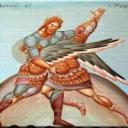Yahoo Answers is shutting down on May 4th, 2021 (Eastern Time) and beginning April 20th, 2021 (Eastern Time) the Yahoo Answers website will be in read-only mode. There will be no changes to other Yahoo properties or services, or your Yahoo account. You can find more information about the Yahoo Answers shutdown and how to download your data on this help page.
Trending News
What are the main things that you disagree, with what is widely taught in martial arts classes? Do you have reasons for those disagreements?
Thanks in advance for all the answers and feel free to elaborate:)
By the way, I think that some of my questions are quite misunderstood by some. I respect all the answers, and my questions are mainly in order to see opinions on matters related to martial arts, rather than something else.....
12 Answers
- LiondancerLv 77 years ago
Gun defense or worse, gun defense for kids. I doubt any of those instructors ever even shot a gun.
You wear ear protection to shoot and there is a reason for it. Having a gun go off (which is quite possible if you try to defend against it) next to your head without ear protection hurts your ears a lot and will most people startle at a minimum. A startle or hesitation in a gun defense situation is a bad thing.
Some guns have a slide. You place your hand there like a lot of people teach during defense you are in for the finger pinch of your life.
The idea that you can move your body faster than the guy with the gun can pull the trigger/move one finger. That is a big chance with huge odds that you are taking right there.
Some guns have a very sensitive trigger. If you grab your opponent's hand or wrist, let alone slap it out of the way you stand a good chance the gun will go off. If you don't get hit you still have a stray bullet to consider.
I also have a beef with lowering the standards so 'Johnny can do'. A student will give you what is expected. If you don't expect much your student will never give you much. I had an interesting experience with that. Had a kid (homeschooler) join kids classes. He practiced, tried very hard and was a pleasure to have. He progressed and I think he could have been good. Then he got into public school where noone fails and mediocre is acceptable if you pretend to try just a little. The kid somehow thought that he could get by by not trying so hard all the time in martial arts too and his performance got sloppy, he didn't try hard anymore and eventually got frustrated and quit.
It is also my experience that lowering the standards so kids can get a black belt is still lowering the standards. If you keep the standards it is amazing to see that kids will live up to it and are ready to meet those standards at about age 18 and sometimes even 16. Good standards in a school perfectly match up with the age. I think that should tell us something right there.
- callsignfuzzyLv 77 years ago
I wish martial arts studies were approached with a more academic mindset, and that it wasn't so taboo to question what was being taught.
Case in point: the legend that Bodhidharma brought martial arts to China, which was the originator for martial arts everywhere. There's plenty of examples in archaeology of martial arts existing in China, India, Egypt, and Greece that predate Bodhidharma's existence. According to "Chinese Martial Arts Training Manuals: A Historical Survey" by Brian Kennedy and Elizabeth Guo, a lot of the stuff that gets passed on regarding Bodhidharma and Shaolin is largely the result of works of fiction from around the late 1800's and early 1900's.
Same thing with pressure points, as an extension of Chinese medicine. The notion that certain points have to be hit in a certain order or during a certain time of day is not only impractical, but has no medical basis. Certain points cause pain because the nerves there are easy to access, not because you're affecting the liver by pressing the leg or something; certain points produce knockouts because they cause a change in blood pressure or shake the brain, not because you're activating the destructive cycle of the Five Elements, or whatever.
On a more technical level, I dislike training people to perform in a sub-optimal way. Sitting in a deep horse stance with the fists at the hips is OK for conditioning, *maybe*, but don't try to teach people to fight from there. Defending against attacks that are extremely unlikely to occur in the real world, like lunge punches and holding both wrists from behind, is also not an effective use of time, if someone is training for practical purposes.
Slight caveat- I know some people like to learn a system. That is their primary goal, and pragmatic self-protection is of secondary concern. That's fine, as long as they're honest about what they're doing.
At the heart of it, I want martial arts to be approached like a science. Question what's out there, conduct experiments, do research. We know more about physics, anatomy, sports science, psychology, history, archaeology, nutrition, criminology, etc. than ever before. Due to the prevalence of recording devices and challenge matches, we have more footage than ever before of how people, trained or untrained, behave in a confrontation, and what techniques occur the most and have the highest success rate. We've got at least one hundred years worth police reports and court documents regarding violence. Why aren't we applying all of that, daily, to the study of martial arts, if we're interested in the truth?
- YmirLv 67 years ago
Group think's horrible. Instructors that get stuck in a rut and want additional training but have neither the creative intent nor the will to get it, and are just passing time by teaching, is probably not a good environment to learn in.
Fees might be annoying, if there is no competition or competitive pricing.
Commute is also annoying. A lot of things can be tolerated by living in or near dojo/training place.
The training methods, these days, I don't really mind. I can connect the dots now, so no matter what training method people use to learn or teach, I can gain at least some benefit. Eventually.
- 7 years ago
One dangerous thing is that you can grab the arm of someone attacking you with a knife. Even if you can see the knife, it's unlikely you could catch a stabbing arm. Catching a slashing arm is more likely. But in all cases, you could very easily get cut in trying to do so, and as the Filipino martial arts (Kali - e.g. Escrima & Arnis) all teach, one cut can kill!
Police officers are trained to be observant, and only the best applicants get selected, so they'll likely be very observant even before they're trained. And yet I read of 3 police officers trying to apprehend a man, (at night sure, but there could've been street-lighting) and during the fight all 3 thought they'd been punched very hard. It wasn't till after they'd subdued they guy that they realized they'd been stabbed! Now that's THREE very observant people, and not one saw the knife!
Don't try to grab a knife-arm!
Even martial arts folk have been cut doing so in demonstrations!
- How do you think about the answers? You can sign in to vote the answer.
- 7 years ago
One of the biggest things is that younger students or even adult beginners are sometimes taught with lower standards in mind and many instructors find that acceptable and feel that as the student progresses or gets older they will then change and improve. I have found that to not largely be the case. When younger or beginner students are given low standards and those standards are applied in their work and practice they then tend to carry those low standards forward in their approach to things in general in taking and doing martial arts. Not only the above but a student that practices and does things poorly for a duration of time is not suddenly going to change how well they approach something or doing it suddenly because they are older or now testing for their black-belt. They will instead take the approach they have become accustom to or do that which they have been doing the same in general.
Instead I would start my younger or beginner adult students off with the same standards as I expected of my black-belts. With younger students I would also have to first teach them about quality and being able to measure that some and discern that and then go from there. Way too many instructors shoot themselves and their students in the foot early on when they first start out because they take the approach that something is good enough for now or thats good enough for them because they are younger. That really only sets them up for failure down the road and a student reaching their fullest potential and also any really high standards that a school and instructor might wish to apply.
- ExploringLifeLv 77 years ago
There are rules in fighting when there really are none. Or those who follow rules are at a disadvantage.
Training only in the air can make you effective in a real fight. Not learning to hit hard on solid objects. Not sparing with at least pads. Always fighting against the same style, especially if it never involves going to the ground. If you're win tournament sparring, then you must be a good fighter. You may be a good fighter, but you don't know until you've been in several real fights.
When in doubt, do what Hollywood does, drop any weapon you have in your hand, so you can use your hands and feet for fighting. This is what "real" martial artists do. Or you could do what the police do, be at least one level up when it comes to weapons...never fight equally, give the opponent a chance, let them back on their feet, or fight fair.
- 7 years ago
1st and foremost, promoting students that didn't really learn anything for fear of telling the students or the students' parents they failed or aren't ready to test.
2nd, using Japanese terms, commands, writing, etc. in Korean martial arts and vice versa. Also, even worse, not even knowing the difference at all. If you want a traditional martial art, don't learn the wrong traditions, right? I don't want to hear excuses about the 1960s, it's not the 1960s anymore.
3rd, non contact sparring.
and to quote Akban, "And so much more!"
Source(s): MA - Mild MaxLv 47 years ago
'Taught' isn't the word I'd use even though a lot do actually teach it but so many schools allow and even encourage their students to believe that getting in a multiple attacker scenario is ever a good idea. There have been people who have done it and come out on top but the odds against such a feat are just massive.
I wish more schools would teach their students to be realistic about it.
- Anonymous7 years ago
In short garbage self defense.
Learn-at-home DVD martial arts courses. Can't get to the dojo? No problem. Earn your black belt in the comfort of your living room. Really?
Extreme or Tricking martial arts. These are strictly demonstration arts devised as crowd pleasers. Competitors perform quasi-martial art routines based on acrobatics interspersed with enough karate shouts to give you a headache that'll last a week.
Far-fetched breaking routines. Breaking slabs of wood with a shuto (blade-hand) or kick can be a viable way to measure striking efficiency. Sometimes it gets to be a bit much. A friend of mine used to set bricks on fire before busting them apart with a hammer fist at demos. Nice. Once, I watched a competitor on TV attempt this same trick, but somehow some of the lighter fluid ended up on the floor, igniting the mats and setting the entire venue ablaze. Also, is being able to break a fifty inch-thick chunk of ice with your forehead indicative of any combative skill? Talk about headaches. Still, playing with ice is safer than fire.
In short, impractical breaking. Few martial artist's these days break the "real deal" anymore. People used to break legit 2 by 4s. Now they have these tricks, cloak and dagger, to weaken the wood etc.
Training uniforms that are so patched up they resemble a billboard. Some of these jiu-jitsu and taekwondo guys look more like race car drivers.
Camouflage belts. When colored belts were introduced in judo over a century ago, there were just white, brown, and black. Much later, more incremental colors were added to appease the masses. Not a bad idea. I can tolerate yellow, orange, etc., but camouflage? Come on.
The "my style and only my style is the ultimate fighting system" mantra. Please shut up already.
Gossip in the dojo. I don't care what Jane or anyone else does with their life. It's none of my business or yours. Few things are more damaging and hurtful (and cowardly) than malicious trash talk behind someone's back. Definitely shut up.
People who think they can develop as martial artists without hard work. Real martial arts are both an intellectual and physical pursuit. Deal with it.
Cheesy martial arts flicks, especially the American-made variety from the 80s and others. These films have given a false image of martial arts.
Not Sparring: Sparring is an essential. You have learned the technique, now it's time to test it in a controlled combat setting. Sparring is like taking pieces of a puzzle and putting them together, you have the means, now it's time for you to make it work, put what you learned to the test.
Some martial artist's go 5 years without sparring, get their first dan, end up having to defend themselves, and get their a$$es whooped, bc they don't know how to cope.
Child Blackbelts: No. Just no. I don't agree with it. Even a "child black belt" but that's just me.
And so much more! Anything indicating of a mc-dojo. Mc-dojos piss me off to a high level, they really do. Bc they make money teaching garbage and doing things the watered down easy route.
Well I think that covered most of my thoughts perhaps.
Off to work I go.
Source(s): Martial Artist 14 yrs and counting. - possumLv 77 years ago
Taekwondo
*** Self-defense...
The official WTF/Kukkiwon website and textbook, which describes "all" elements of Taekwondo. By "all", I mean that which they deem important. They have textbooks and classes for everything about taekwondo - including forms. But they do not go into details about form applications. They have no curriculum for self-defense - not even basic SD concepts. In fact, the entire concept of SD is de-emphasized. All instructors teach forms, few have understanding of their meanings. Test criteria officially omits self-defense.
One may draw the conclusion that Taekwondo is not to be used for self-defense.
*** Taekwondo history...
Every instructor I've ever trained with will cite the 3 dynasties (pakje, silla, koguro) several thousand years ago, and how they have all of these fighting systems. Yet for half a century in Korean history, all elements of fighting were eliminated from society - except for Japanese fighting (karate, judo, kendo).
No two people ever had a conversation in 1950 that went something like this: "Hey, wanna head for the bar tonight?", "Naw, I gotta go to taekwondo class".
That's because Taekwondo DIDN'T EXIST in 1950. Whatever it looked like in 1960 was because of what the learned from their Japanese instructors, and whatever it looked like in 1970 was because they tweaked it so it didn't look Japanese.
The minute somebody starts spouting the 3 dynasties, I walk away in disgust. Taekwondo is only 60-odd years old, if that. The forms, the concept of forms, the techniques, the uniforms... it's all derived from Japanese. Some influential instructors had influence from other styles, like Kung Fu.
*** Styles...
With all due respect to several members here in Y!A, I don't subscribe to the idea that there are a hundred styles. There are 4: WTF (aka: Kukkiwon), ITF, ATA, and arguably Tangsoodo. If you define a style as that which is governed by a widely recognized sovereign organization, you might consider ITF to really be 3 styles (there are 3 organizations all claiming they are "the" ITF: North Korea, Austria, and Canada). There is also Rhee Taekwondo, and Tangsoodo has several (2 that I'm aware of) organizations. So if political organization is your definition of a style, then there would be 7 styles. But if you consider the more traditional definition of style which is the set of forms used, then there are only 4: WTF (uses Taeguek family), ITF (uses Chang Hon), ATA (uses Songahm), and Tangsoodo/Rhee (uses Pyong Ang). Count them: 4 styles.
Whether you buy into 4 styles or 7, there aren't a hundred of them.
Of course, there are schools that teach "taekwondo" and have no ties to an organization. This is true today as it was back in the early days of Taekwondo's birth (in the 1950's....) You might make the argument that each independent school (kwan, or "kwoon" as they say in Chinese) is itself a style. In this case, there would be literally thousands if you counted them over the years. You can't say "Bob's Taekwondo" isn't a style, and also say that "Chung Do Kwan" (a single school back in the 60's) IS a style, either both are styles, or neither are styles. Bob may not have influence, and clearly Chung Do Kwan (and others) did have influence. But both were single schools.
4 or 7, vs thousands? Meh. But not a hundred.
*** Self-defense philosophy
Some taekwondo schools - go to the internet and watch videos, they're all over the place - perform self-defense using terribly inefficient and unrealistic scenarios. Many are demo teams looking for the hype and not so much for practical use. Punch and kick hard! Wrap your legs around his neck and toss him on the floor! Rip his head off! Unsocket his shoulder! what? Really? Is that what they're teaching their students? Nothing about balance, getting off the line, getting out of the way? Does anyone know how much human strength is required to "karate chop" someone's back to knock them flat on the floor cold?
What little self-defense is taught is laughable. There are good schools, but there are a great many that seem to get their routines from a 1960's episode of Batman and Robin, or maybe a modern Teenage Mutant Ninja Turtle movie. It's embarrassing to watch, really - and it's ubiquitous.
EDIT:
@Kokoro - If the names end with "kwan" - as in "chung do kwan", "ji do kwan", "oh do kwan", etc, then they are the individual schools - not organizations or disparate forms - that I mention. Some eventually became organizations, but by then, they'd all adopted the same forms and even united under WTF or ITF.
Here's another way to look at it: Would you consider "MMA" to be a style? If so, how many MMA styles out there? Or are they all doing the same thing? However you answer that, that is what happened to Taekwondo in it's older days. Rather than bringing in muay thai and jujitsu like today's MMA figters do, they brought in karate and judo, and maybe some other style influences.
Another way: how many styles of pizza are there? Round and square? Or does each pizza shop have a style? Or organizationally, is there just pizza hut and dominos?
I don't think there's a right or wrong answer, much depends on your definition of "style". I tend to think of it as a distinct set of techniques (which is not enough to separate taekwondo from karate), a set of training methodologies (again, not enough to separate tkd and karate), a distinct culture, and governed by an organization. Now we're getting somewhere. But my definition would leave only: WTF, ITF, ITF, ITF, ATA, TangSooDo, and Rhee. There are smaller organizations out there, so, I prefer to further refine it to a common set of forms, leaving: WTF/Taeguek, ITF/Chang Hon, ATA/Songahm, and TangSooDo-Rhee/Pyong Ahn. That's 4 styles for me.
I don't argue when someone says there are a hundred styles, but when that number is spouted, I tend to think they are probably listing individual schools as a style, and then are severely undercounting the actual number out there.









